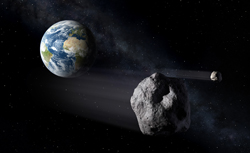Advanced research network on asteroid and space debris manipulation
Asteroids and space debris represent a significant hazard for space and terrestrial assets; at the same time asteroids represent also an opportunity. In recent years it has become clear that the increasing population of space debris could lead to catastrophic consequences in the near term.
The Kessler syndrome (where the density of objects in orbit is high enough that collisions could set off a cascade) is more realistic than when it was first proposed in 1978. Although statistically less likely to occur, an asteroid impact would have devastating consequences for our planet.

Image:ESA
Although an impact with a large (~10 km) to medium (~300 m) sized, or diameter, asteroid is unlikely, still it is not negligible as the recent case of the asteroid Apophis has demonstrated. Furthermore impacts with smaller size objects, between 10 m to 100 m diameter, are expected to occur more frequently and hence are, proportionally, equally dangerous for humans and assets on Earth and in space.
Stardust is a unique training and research network devoted to develop and master techniques for asteroid and space debris monitoring, removal/deflection and exploitation.
- Stardust will train the next generation of engineers, scientists and decision makers to protect our planet, save our space assets, and turn the threat represented by asteroids and space debris in an opportunity.
- Stardust will push the boundaries of space research with innovative ideas and visionary concepts.
- Stardust will integrate multiple disciplines, from robotics, to applied mathematics, from computational intelligence to astrodynamics, to find practical and effective solutions to the asteroid and space debris issue.
The scientific program focuses on a number of underpinning areas of research and development that are fundamental to any future and present initiative aiming at mitigating the threat posed by asteroids and space debris, and is divided into three major research areas: Modelling and Simulation, Orbit and Attitude Estimation and Prediction, and Active Removal/Deflection of Non-cooperative Targets.